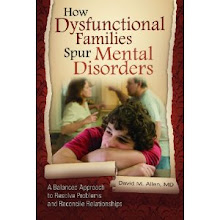In my
last post, I mentioned that the American Psychiatric Association rejected the
diagnosis of Developmental Trauma Disorder in 2011, and refused to acknowledge
that “…childhood adverse experiences lead to substantial developmental
disruptions” and added that this idea is “more clinical intuition than
research-based fact.”
In fact, there have been numerous studies showing a correlation between ACEs and a wide variety of clinical conditions. Below are brief descriptions of the results of four studies, recently published, addressing this contention. One is a review and meta-analysis, which is a research process used to systematically synthesize or merge the findings of, in this case, 39 (!) single, independent studies, using statistical methods to calculate an overall or 'absolute' effect.
Of course, the studies do only show correlations, which
means that they do not “prove” that ACE’s actually cause psychiatric
disorders or even symptoms. But the correlations are as good as any in the
psychiatric research literature, which is pretty much minimal in findings that prove actual causation for almost every psychiatric disorder.
Adverse Childhood Experiences
Among Adults With Eating Disorders: Comparison To A Nationally Representative
Sample And Identification Of Trauma
The primary objectives of the current study were: (1) to examine
and compare ACEs between two samples: treatment-seeking adults, and a
nationally representative sample of adults, (2) to characterize ACEs items and
total scores across demographic and diagnostic information in adults seeking
treatment for an ED, (3) to statistically classify ACEs profiles using latent
class analysis, and (4) to examine associations between ACEs profiles and
diagnosis. Results: Patients with EDs had significantly higher ACEs
scores than the nationally representative sample. Within patients with EDs, four latent
classes of ACEs item endorsement were identified. Patients with other specified
feeding or eating disorder (OSFED) and binge eating disorder (BED) were more
likely to fall into the "Household ACEs" and "Abuse ACEs" groups,
respectively, compared to anorexia nervosa-restricting subtype (AN-R).
Conclusion: Patients with EDs reported more ACEs than the nationally
representative sample, across all ED diagnoses.
“Adverse childhood experiences among adults
with eating disorders: comparison to a nationally representative sample and
identification of trauma profiles.” Rienecke,
Johnson et.al. Journal of Eating Disorders , volume 10,
Article number: 72 (2022).
Considerable Mental Health Burden Associated
With Childhood Trauma
Trauma is associated with
increased odds of anxiety disorders and any psychiatric disorder at age 6 years.
There is a considerable mental health burden in association with childhood
trauma.
“The association between childhood trauma and psychiatric disorders in low-income and middle-income Countries." Alckmin-Carvalho et. al., The Lancet Psychiatry, Oct. 31, 2022.
Association of Neural Connectome With Early Experiences of Abuse in Adults
In this
cohort study of 768 participants, individuals with abuse experienced during
childhood (but not adolescence) demonstrated an altered connectome [connections between brain neurons] of greater
functional connectivity [changes in usual and not pathological connections in various brain areas] associated with somatomotor and dorsal-ventral
attention brain networks, irrespective of current diagnosis or symptom state.
"Association of Neural Connectome With Early Experiences of Abuse in Adults." Korgaonkar et. al., JAMA Network Open. 2023;6.
A Systematic Review and Meta-Analysis of the Relationship Between Childhood Adversity and Adult Psychiatric Disorder.
A review and analysis of 39 different studies suggests that childhood and adolescence is an important time for risk for later mental illness, and an important period in which to focus intervention strategies for those known to have been exposed to adversity, particularly multiple adversities. There was some evidence of a dose-response relationship with those exposed to multiple forms of maltreatment having more two and a half times odds of developing a mental disorder.
“A revised and extended systematic review and meta-analysis of the relationship between childhood adversity and adult psychiatric disorder [Review]." McKay et. al., Journal of Psychiatric Research, 156 (2022).








